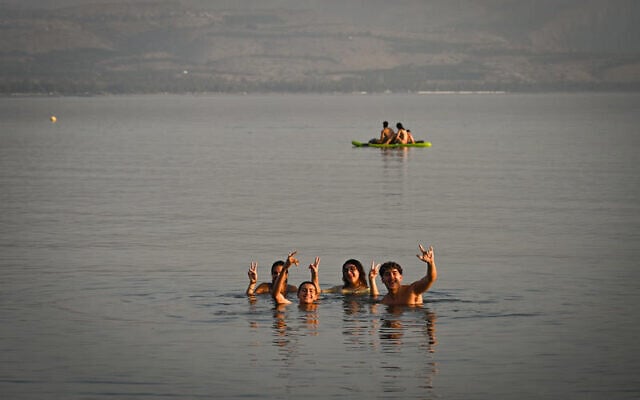The Water Authority has started channeling desalinated water to the Sea of Galilee, marking the first ever attempt anywhere in the world top up a freshwater lake with processed seawater.
The groundbreaking project, years in the making and a sign of both Israel’s success in converting previously unusable water into a vital resource and the rapidly dropping water levels in the country’s largest freshwater reservoir, was quietly inaugurated on October 23.
The desalinated water enters the Sea of Galilee via the the seasonal Tsalmon Stream, entering at the Ein Ravid spring, some four kilometers (2.5 miles) northwest of what is Israel’s emergency drinking source.
Firas Talhami, who is in charge of the rehabilitation of water sources in northern Israel for the Water Authority, told The Times of Israel that he expected the project to raise the lake’s level by around 0.5 centimeters (0.2 inches) per month.
The move has also reactivated the previously dried-out spring, allowing visitors to once again paddle down the Tsalmon, which now flows with desalinated water.
Get The Times of Israel's Daily Edition by email and never miss our top stories
By signing up, you agree to the terms
On Monday, the level of the lake stood at 213.33 meters (699.9 feet) below sea level, just a third of a meter (13 inches) above what is called the lower red line, the lowest point the water level can drop before pumping risks damaging the ecosystem.
Israel typically pulls hundreds of millions of cubic meters annually from the lake to supply local communities and augment its supply of desalinated water.
 The Eshkol water reservoir facility in northern Israel, from where water flows south along the national water carrier, photographed on March 9 2011. (Nati Shohat/Flash90)
The Eshkol water reservoir facility in northern Israel, from where water flows south along the national water carrier, photographed on March 9 2011. (Nati Shohat/Flash90)
Talhami said the flow of desalinated water would be maintained for at least the next six months.
Two pipes are in place a few hundred meters apart to bring the water to the lake, but only one, which is designed for a lighter flow of water, is currently operational, sending 1,000 cubic meters (264,000 gallons) per hour into the body of water.
The second, which would bring even more water into the Sea of Galilee, may be turned on in the future, depending on how much the Water Authority decides is needed.
The Authority could increase the flow to 1,500, or even 2,000 cubic meters per hour, Talhami said, depending on several factors, including the amount of rain that falls this winter, and the amount of surplus desalinated water that will be available.
 Israelis enjoy the northern shores of the Sea of Galilee just before sunset during unseasonably warm weather, November 7, 2025. (Michael Giladi/Flash90)
Israelis enjoy the northern shores of the Sea of Galilee just before sunset during unseasonably warm weather, November 7, 2025. (Michael Giladi/Flash90)
Tests carried out by scientists have indicated that the project will not have any significant deleterious effect on ecosystems, though there have also been some concerns that the desalinated water could harm local ecology by diluting the lake’s relatively high salinity.
The idea for the project was born toward the end of several disastrous drought years, between 2013 and 2018, when the lake’s level approached an all-time low. With desalinated water already set to piped to communities in the nearby Lower Galilee, officials decided they could hook the lake into the system as well.
 Work on a pipe that will channel desalinated water to the Sea of Galilee, June 3, 2021 (Firas Talhami, Water Authority)
Work on a pipe that will channel desalinated water to the Sea of Galilee, June 3, 2021 (Firas Talhami, Water Authority)
A pioneer in turning salty seawater into something drinkable, Israel currently desalinates enough of the wet stuff to supply most of its own population and some nearby countries as well, taking pressure off the Sea of Galilee and underground aquifers.
Last winter, just half of the yearly average rainfall fell in Israel, with many places in and around the Sea of Galilee getting just 40% of the average or less, according to Israel Meteorological Service data.
The total fell well short of forecasted totals, and marked a stark shift from several previous years, which had seen enough rain to fill the lake to levels not seen in decades.
In the past year, signs of falling water levels at the lake have been starkly visible at beaches along its shrinking rim, with large expanses of sand, rock and soil normally far underwater now exposed and lifeguard stations once licked by waves sitting well inland.
 A lifeguard stand at the Sea of Galilee on October 13, 2025. (Michael Giladi/Flash90)
A lifeguard stand at the Sea of Galilee on October 13, 2025. (Michael Giladi/Flash90)
For the coming winter, the IMS is forecasting 80% of the annual average rainfall, although officials point out that it’s hard to be precise with long-term predictions.
As part of the effort to refill the Sea of Galilee, only 20 million cubic meters, a tenth of the usual amount, will be pumped out of the lake for the national water carrier, which brings water from northern Israel to the more arid south.
Amid drought fears, some 20,000 dunams (just under 5,000 acres) of agricultural fields normally fed by the lake’s water are expected to go without over the coming year.
.png)



